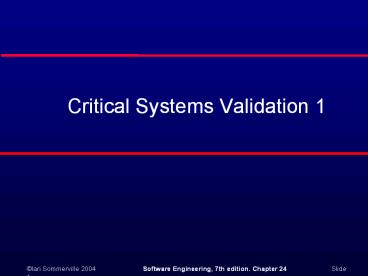Critical Systems Validation 1 - PowerPoint PPT Presentation
1 / 19
Title:
Critical Systems Validation 1
Description:
Objectives To explain how system reliability can be measured and how reliability growth models can be used for reliability prediction To describe safety arguments and ... – PowerPoint PPT presentation
Number of Views:72
Avg rating:3.0/5.0
Title: Critical Systems Validation 1
1
Critical Systems Validation 1
2
Objectives
- To explain how system reliability can be measured
and how reliability growth models can be used for
reliability prediction - To describe safety arguments and how these are
used - To discuss the problems of safety assurance
- To introduce safety cases and how these are used
in safety validation
3
Validation of critical systems
- The verification and validation costs for
critical systems involves additional validation
processes and analysis than for non-critical
systems - The costs and consequences of failure are high so
it is cheaper to find and remove faults than to
pay for system failure - You may have to make a formal case to customers
or to a regulator that the system meets its
dependability requirements. This dependability
case may require specific V V activities to be
carried out.
4
Validation costs
- Because of the additional activities involved,
the validation costs for critical systems are
usually significantly higher than for
non-critical systems. - Normally, V V costs take up more than 50 of
the total system development costs.
5
Reliability validation
- Reliability validation involves exercising the
program to assess whether or not it has reached
the required level of reliability. - This cannot normally be included as part of a
normal defect testing process because data for
defect testing is (usually) atypical of actual
usage data. - Reliability measurement therefore requires a
specially designed data set that replicates the
pattern of inputs to be processed by the system.
6
The reliability measurement process
7
Reliability validation activities
- Establish the operational profile for the system.
- Construct test data reflecting the operational
profile. - Test the system and observe the number of
failures and the times of these failures. - Compute the reliability after a statistically
significant number of failures have been observed.
8
Statistical testing
- Testing software for reliability rather than
fault detection. - Measuring the number of errors allows the
reliability of the software to be predicted. Note
that, for statistical reasons, more errors than
are allowed for in the reliability specification
must be induced. - An acceptable level of reliability should be
specified and the software tested and amended
until that level of reliability is reached.
9
Reliability measurement problems
- Operational profile uncertainty
- The operational profile may not be an accurate
reflection of the real use of the system. - High costs of test data generation
- Costs can be very high if the test data for the
system cannot be generated automatically. - Statistical uncertainty
- You need a statistically significant number of
failures to compute the reliability but highly
reliable systems will rarely fail.
10
Operational profiles
- An operational profile is a set of test data
whose frequency matches the actual frequency of
these inputs from normal usage of the system. A
close match with actual usage is necessary
otherwise the measured reliability will not be
reflected in the actual usage of the system. - It can be generated from real data collected from
an existing system or (more often) depends on
assumptions made about the pattern of usage of a
system.
11
An operational profile
12
Operational profile generation
- Should be generated automatically whenever
possible. - Automatic profile generation is difficult for
interactive systems. - May be straightforward for normal inputs but it
is difficult to predict unlikely inputs and to
create test data for them.
13
Reliability prediction
- A reliability growth model is a mathematical
model of the system reliability change as it is
tested and faults are removed. - It is used as a means of reliability prediction
by extrapolating from current data - Simplifies test planning and customer
negotiations. - You can predict when testing will be completed
and demonstrate to customers whether or not the
reliability growth will ever be achieved. - Prediction depends on the use of statistical
testing to measure the reliability of a system
version.
14
Equal-step reliability growth
15
Observed reliability growth
- The equal-step growth model is simple but it does
not normally reflect reality. - Reliability does not necessarily increase with
change as the change can introduce new faults. - The rate of reliability growth tends to slow down
with time as frequently occurring faults are
discovered and removed from the software. - A random-growth model where reliability changes
fluctuate may be a more accurate reflection of
real changes to reliability.
16
Random-step reliability growth
17
Growth model selection
- Many different reliability growth models have
been proposed. - There is no universally applicable growth model.
- Reliability should be measured and observed data
should be fitted to several models. - The best-fit model can then be used for
reliability prediction.
18
Reliability prediction
19
Key points
- Because of the high costs of system failure, the
costs of critical systems validation is usually
much higher than for non-critical application
systems - Reliability measurement relies on exercising the
system using an operational profile - a simulated
input set which matches the actual usage of the
system. - Reliability growth modelling is concerned with
modelling how the reliability of a software
system improves as it is tested and faults are
removed.































